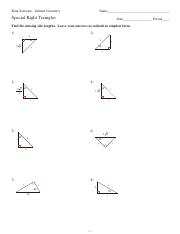
Therefore in a 30°-60°-90° triangle the sides are in the ratio 1 : 2 : which is what we set out to prove.Ĭorollary. That is,įrom the Pythagorean theorem, we can find the third side AD: AD 2 + 1 2 This implies that BD is also half of AB, because AB is equal to BC. Now, since BD is equal to DC, then BD is half of BC. Triangle ABD therefore is a 30°-60°-90° triangle. Then AD is the perpendicular bisector of BC ( Theorem 2). ( Theorems 3 and 9)ĭraw the straight line AD bisecting the angle at A into two 30° angles. It is based on the fact that a 30°-60°-90° triangle is half of an equilateral triangle.ĭraw the equilateral triangle ABC. Here is the proof that in a 30°-60°-90° triangle the sides are in the ratio 1 : 2 . Therefore AP is two thirds of the whole AD. Let ABC be an equilateral triangle, let AD, BF, CE be the angle bisectors of angles A, B, C respectively then those angle bisectors meet at the point P such that AP is two thirds of AD.įor, since the triangle is equilateral and BF, AD are the angle bisectors, then angles PBD, PAE are equal and eachĪnd the side BD is equal to the side AE, because in an equilateral triangle the angle bisector is the perpendicular bisector of the base.Īngles PDB, AEP then are right angles and equal.īut AP = BP, because triangles APE, BPD are conguent, and those are the sides opposite the equal angles. Prove: The angle bisectors of an equilateral triangle meet at a point that is two thirds of the distance from the vertex of the triangle to the base. Now, the area A of an equilateral triangle is If we call each side of the equilateral triangle s, then in the right triangle OBD, ½ s Triangle OBD is therefore a 30-60-90 triangle. If we extend the radius AO, then AD is the perpendicular bisector of the side CB. Hence each radius bisects each vertex into two 30° angles. The three radii divide the triangle into three congruent triangles. In the right triangle DFE, angle D is 30°, and side DF is 3 inches. (In Topic 6, we will solve right triangles the ratios of whose sides we do not know.) Whenever we know the ratio numbers, the student should use this method of similar figures to solve the triangle, and not the trigonometric Table. Therefore, side nI>a must also be multiplied by 5. Now, side b is the side that corresponds to 1. Side b will be 5 × 1, or simply 5 cm, and side a will be 5 cm.Īlternatively, we could say that the side adjacent to 60° is always half of the hypotenuse. Therefore every side will be multiplied by 5. Now in every 30°-60°-90° triangle, the sides are in the ratio 1 : 2 :, as shown on the right. Whenever we know the ratios of the sides, we can solve the triangle by the method of similar figures.Īnd so in triangle ABC, the side corresponding to 2 has been multiplied by 5. Since this is a right triangle, and angle A is 60°, then the remaining angle B is its complement, 30°. To solve a triangle means to know all three sides and all three angles. Solve the right triangle ABC if angle A is 60°, and side c is 10 cm. Similarly for angle B and side b, angle C and side c.Įxample 3. If an angle is labeled capital A, then the side opposite will be labeled small a. Therefore, cos 30° =īefore we come to the next Example, here is how we relate the sides and angles of a triangle: To cover the answer again, click "Refresh" ("Reload").Īs for the cosine, it is the ratio of the adjacent side to the hypotenuse. To see the answer, pass your mouse over the colored area. You can see that directly in the figure above. According to the property of cofunctions (Topic 3),

Since the cosine is the ratio of the adjacent side to the hypotenuse, you can see that cos 60° = ½.Īnswer. The student should sketch the triangle and place the ratio numbers. For any problem involving a 30°-60°-90° triangle, the student should not use a table. First, we can evaluate the functions of 60° and 30°.Īnswer.


Here are examples of how we take advantage of knowing those ratios.

The cited theorems are from the Appendix, Some theorems of plane geometry. Also, while 1 : : 2 correctly corresponds to the sides opposite 30°-60°-90°, many find the sequence 1 : 2 : easier to remember.) Note that the smallest side, 1, is opposite the smallest angle, 30° while the largest side, 2, is opposite the largest angle, 90°. (For the definition of measuring angles by "degrees," see Topic 12.) In a 30°-60°-90° triangle the sides are in the ratio They are special because, with simple geometry, we can know the ratios of their sides. The other is the isosceles right triangle. THERE ARE TWO special triangles in trigonometry.


 0 kommentar(er)
0 kommentar(er)
